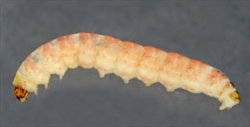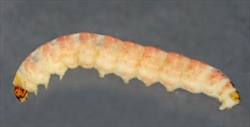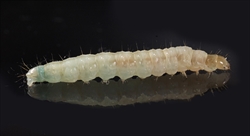Background
The Tortricoidea is a rather homogeneous superfamily, containing one family, the Tortricidae. It is a diverse, ubiquitous group that currently stands at over 10,350 named species, with most represented in temperate areas and tropical highlands. The family includes many serious economic pests of agriculture, horticulture and forestry. Larvae have diverse lifestyles and include leafrollers, leaf tiers and borers in roots, stems and fruits. They feed on an enormous variety of plants. Most pest species are in the Archipini (Tortricinae), usually as externally feeding leafrollers, and the Grapholitini (Olethreutinae) that feed internally in fruits and stems.
Short Description
Tortricid larvae are generally small, and appear smooth due to their lack of secondary setae. The head is usually semiprognathous. Leaf rollers tend to wriggle vigorously when disturbed. There are two general forms related to their biology. Borers that feed internally, tend to be rather stout (Fig. 1), whereas external feeders, such as leaf rollers, tend to be long and slender (Fig. 2).
Diagnosis
Adapted from Stehr et al. (1987), Horak (1999) and Regier et al. (2012).
The following four characteristics are diagnostic for the Tortricidae:
- A well-developed, long anal comb (anal fork) with relatively long, straight prongs, often present. Diagnostic for the Tortricidae (although it is often secondarily lost in many species (Horak 1999). The term anal fork differentiates this structure from the more typical anal comb, with short teeth, found in other families. Anal forks are also found in the Gelechiidae. In the Tortricidae it is used for flicking frass away from shelters.
- The following combination of setal characters are diagnostic for the Tortricidae.
- T1 - L group trisetose. This distinguishes the Tortricidae from the Pyralidae and Crambidae, and most other Macrolepidoptera, in which the L group is usually bisetose on T1.
- Secondary setae absent In the Tortricidae (Fig. 1, Fig. 2).
Other important characteristics:
- SD1, SD2 and the spiracle are on the same pinaculum on A1-A8. In Phricanthini (Tortricinae).
- An enlarged L-pinaculum on T1, extending posteriorly beneath the spiracle. In Cochylini (Tortricinae).
- L-group bisetose on segment A9. In Cochylini (Tortricinae).
Detailed Description
Adapted from Horak (1999) and Stehr et al. (1987).
The mature larvae are generally small with a maximum length of around 25 mm. In shape they range from stout in internal feeders (Fig. 1) to slender in external feeders (Fig. 2). Body patterns are generally rather uniformly plain (Fig. 1, Fig. 2). Secondary setae are absent (Fig. 1, Fig. 2). A characteristic anal fork used for ejecting frass is frequently present.
Head: The head is usually semiprognathous (Fig. 1, Fig. 2). The coronal suture is generally short. The adfrontals extend to or nearly reach the epicranial notch. The epicranial suture is usually short. There are six stemmata. Stemma 6 is always close to 4 and 5.
Thorax: The prothoracic shield is variably pigmented (Fig. 1, Fig. 2) and often has a distinct medial sulcus. The L setal group on T1 is trisetose. L1 is closer to L2 than L3. The SV group on T1 is bisetose but unisetose or bisetose on T2 and T3.
Abdomen: Prolegs on A3-A6 and A10 (Fig. 1). Ventral prolegs usually tapering apically (Fig. 1). The crochets are uni-, bi-, or triordinal, uniserial and arranged in complete circles on the ventral prolegs; on A10 the crochets are arranged in a continuous homoideous band. On A1-A8, L1 and L2 are adjacent and are obliquely or vertically placed. On A3, L1 and L2 are closer to each other than either is to the spiracle. On A3-A6 the SV-group is almost always trisetose.
On A8, SD1 is generally anterior of the spiracle. On A9 the D2 setae are on a common pinaculum and are closer to each other than D1. On the same segment, D1 is usually closer to SD1 than D2; D1 and SD1 are often on the same pinaculum. An anal fork with straight prongs is frequently present. The spiracles are broadly elliptical; on A8 they are generally larger and more dorsad.
Species of Biosecurity Concern
THE FOLLOWING SPECIES IS OF BIOSECURITY CONCERN TO NORTHERN AUSTRALIA
This species is of biosecurity concern to northern Australia. It is an important pest of sugarcane. At present its distribution is limited to Asia. There are also unconfirmed records from Madagascar and Hawaii (Gilligan & Epstein 2014).
Tetramoera schistaceana (grey borer, sugarcane grey borer, sugarcane shoot borer) (Tortricidae: Olethreutinae: Enarmoniini)
Adapted from Gilligan & Epstein (2014).
Diagnosis
- Pinacula small and pigmented
- The abdominal SD1 and SD2 on the same pinacula
- The abdominal L1 seta longer than L3
- A7 – SV setae trisetose
- A9 - SV setae bisetose
- Anal comb (or fork) absent.
Description
The head of the mature caterpillar is yellowish-brown with a small blackish streak near the stemmata. The prothoracic shield is slightly paler than the head. The body is whitish to greyish-yellow but darker dorsally. The suranal shield is brownish-yellow. Pinacula are small and pigmented. This species lacks an anal comb or fork. Important chaetotaxy characteristics are listed in the Diagnosis above. The length of mature larvae is around 20 mm (Meijerman & Ulenberg, 2000).
Biology and Feeding Damage
This species is a stem borer of Saccharum. Young larvae, after hatching, enter a shoot underground, leaving a tiny entry hole. Caterpillars then construct an ascending gallery damaging growing points by severing leaves. This results in ‘dead heart’ (CABI 2019).
Mature caterpillars construct irregular, short tunnels just under the epidermis in stems. Young plants are preferred, but in older canes the tops and older nodes may be damaged.
Current Distribution
- Indonesia
- China
- Taiwan
- The Philippines
- Sri Lanka
- Vietnam
(Gilligan and Epstein 2014)
Caterpillar Host Plants
- sugarcane (Saccharum officinarum)
- wild sugarcane (Saccharum officinarum)
- silvergrass (Miscanthus)
(Gilligan & Epstein 2014)
References
Centre for Agriculture and Bioscience International (CABI) (2019). Plantwise Knowledge Bank. Tetramoera schistaceana (grey borer). https://www.plantwise.org/knowledgebank/datasheet/55270#SymptomsSection. Accessed August 2019.
Gilligan, T. M. and Epstein, M. E. Tortricids of Agricultural Importance. (2014) Colorado State University. Lucid 3.5. Last updated August 2014. http://idtools.org/id/leps/tortai/Tetramoera_schistaceana.htm
Horak, M. (1999). The Tortricoidea. In: Kristensen, N.P. (Ed.), Handbook of Zoology. 4(35.1). De Gruyter, Berlin, New York.
MAF, Plant Health & Environment Laboratory (2011) Oriental Fruit Moth (Grapholita molesta) Updated on 3/31/2014 12:46:05 AM Available online: PaDIL - http://www.padil.gov.au.
Meijerman, L. & Ulenberg, S.A. (2000) Arthropods of Economic Importance. Tortricidae. Eurasian Tortricidae. Accessed August 2019. http://nlbif.eti.uva.nl/bis/tortricidae.php?selected=beschrijving&menuentry=soorten&id=276
Regier JC, Brown JW, Mitter C, Baixeras J, Cho S, et al. (2012) A Molecular Phylogeny for the leaf-roller moths (Lepidoptera: Tortricidae) and its implications for classification and life history evolution. PLoS ONE 7(4): e35574. doi:10.1371/journal.pone.0035574
Stehr, F.W., Martinat, P.J., Davis, D.R., Wagner, D.L., Heppner, J.B., Brown, M.E., Toliver, M.E., Miller, J.Y., Downey, J.C., Harvey, D.J., McFarland, N., Neunzig, H.H., Godfrey, G.L., Habeck, D.H., Appleby, J.E., Jeffords, M., Donahue, J.P., Brown, J.W. & Frack, D.C. (1987) Order Lepidoptera, pp 288–596. In Stehr, F. W. (Ed.), Immature Insects. Kendall/Hunt, Dubuque.


